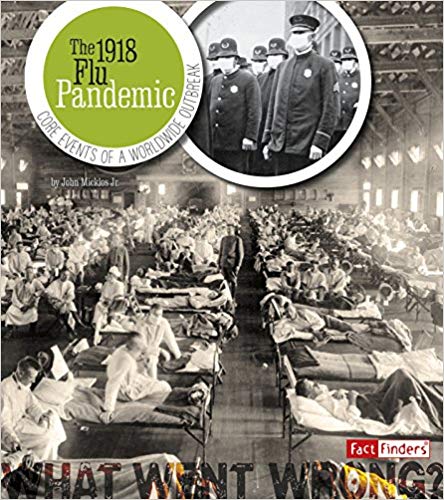 Book Review: The 1918 Flu Pandemic: Core Events of a Worldwide Outbreak
Book Review: The 1918 Flu Pandemic: Core Events of a Worldwide Outbreak
From Capstone Press’s What Went Wrong Series
Author: John Micklos, Jr.
At 32 pages, Micklos’ book about Spanish influenza is aimed at middle grade readers. Short chunks of text make The 1918 Flu Pandemic readable without sacrificing interest or information. Photographs from the era and illustrations are plentiful, and both captions on photographs and fact sidebars contribute even more details about Spanish influenza.
The book is organized into four chapters that explain how Spanish influenza spread in 1918: how normal, seasonal flu outbreaks happen, the deadly and extreme symptoms of Spanish influenza, the lack of a cure, the incredible numbers of victims, and how public health officials dealt with the pandemic. The comparisons to other deadly plagues like smallpox, the Black Plague, and AIDS illustrate how Spanish influenza belongs in the list of great and deadly pandemics.
Some interesting facts I didn’t know:
Farmers who raise pigs and chickens keep the two animals separated on different parts of their farms. This can help prevent bird flu from transferring to pigs, and vice-versa thus lowering the chances to developing a new flu strain that can be transferred to humans.
Typically, the flu virus attaches to either the upper respiratory system (nose and throat) or the lungs. But in the case of the Spanish influenza, the virus attacked both upper and lower respiratory systems.
Other facts I knew that still astound me:
The shear number of people who caught the disease and subsequently died still amazes me. One in four people in the United States caught the flu. Of those Americans struck with Spanish influenza, 675,000 died of the disease. Put another way, seasonal flu typically kills one person in a thousand, but Spanish influenza killed one in fifty. Imagine if there are 100 kids in your fourth grade at your school. Twenty-five would catch the flu, and two of those kids would die. Some experts think as many as 40 million people died worldwide. More people died from influenza in 1918 and 1919 than died in World War I. Micklos quotes flu historian, Alfred Crosby, “1918 [was] the deadliest year in human history.” (p. 27)
Although written for the middle grade audience, adult readers will be surprised by the scope of the pandemic, and students doing research papers will find John Micklos’ The 1918 Flu Pandemic: Core Events of a Worldwide Outbreak to be an interesting, concise, and painless way to gather the basics of Spanish influenza.
